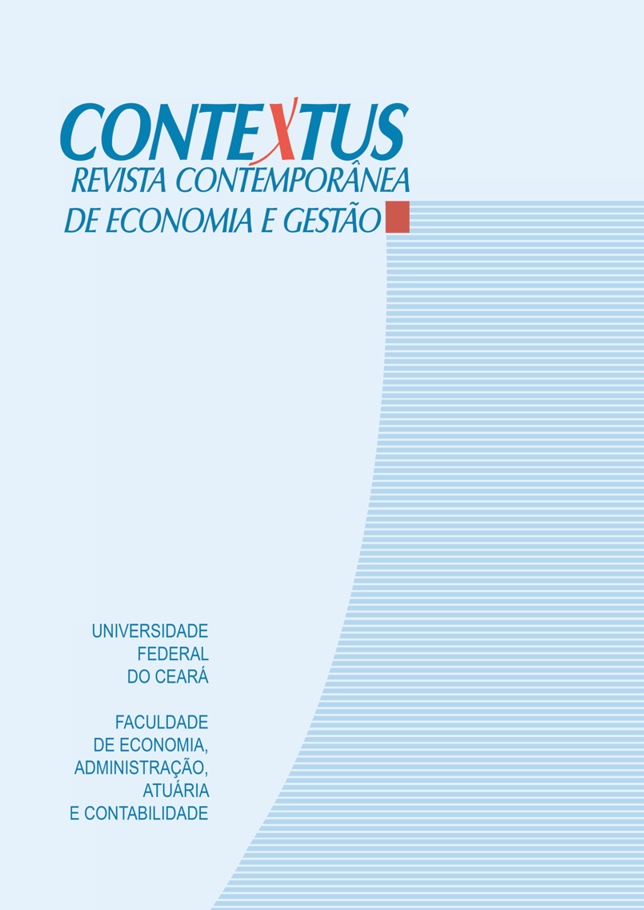Cryptocurrency investment: Analysis by UTAUT with cultural moderators
DOI:
https://doi.org/10.19094/contextus.2024.93100Keywords:
cryptocurrencies, UTAUT, culture, level of education, investor behaviorAbstract
Background: Cryptocurrency assets, known for their high risk, have seen a significant increase in the number of users, driven by the search for new investment opportunities and portfolio diversification. This research aims to explore and evaluate the factors that determine the intention and behavior of investing in cryptocurrencies.
Purpose: The main objective of the study is to understand the effects of the intention to invest in cryptocurrencies using a behavioral theory, adding cultural moderation to the investment behavior model.
Method: Quantitative research that uses the Unified Theory of Acceptance and Use of Technology (UTAUT) as the theoretical lens, the research applied an online questionnaire and obtained 222 valid responses for analysis, data collected from February to May 2021. Data analysis was based on structural equation modelling, with estimation using the partial least squares method.
Results: The results revealed the contribution that UTAUT has on the intention to invest in cryptocurrencies, and that the variables of performance expectancy, social influence and facilitating conditions affect the intention to invest in cryptos.
Conclusions: The level of education, in the sample represented by the majority of risk-prone investors, was a significant and moderating factor in the variations in the result of using the UTAUT in the context of the behavior of cryptocurrency investors.
Downloads
References
Abramova, S., & Böhme, R. (2016). Perceived benefit and risk as multidimensional determinants of bitcoin use: a quantitative exploratory study. International Conference on Information Systems, Dublin, Republic of Ireland, 37. https://informationsecurity.uibk.ac.at/pdfs/Abramova2016_Bitcoin_ICIS.pdf
Agustina, D. (2019). Extension of Technology Acceptance Model (ETAM): Adoption of Cryptocurrency Online Trading Technology. Jurnal Ekonomi, 24(2), 272-287. https://doi.org/10.24912/je.v24i2.591
Alkashri, Z., Alqaryouti, O., Siyam, N., & Shaalan, K. (2020). Mining Dubai government tweets to analyze citizens’ engagement. Recent advances in intelligent systems and smart applications (pp. 615-638). Cham: Springer International Publishing. https://link.springer.com/chapter/10.1007/978-3-030-47411-9_33
Baptista, G., & Oliveira, T. (2015). Understanding mobile banking: The unified theory of acceptance and use of technology combined with cultural moderators. Computers in Human Behavior, 50, 418-430. https://doi.org/10.1016/j.chb.2015.04.024
Bauer, R. A. (1960). Consumer behavior as risk taking. Proceedings of the 43rd National Conference of the American Marketing Association, Chicago, Illinois, 43. https://cir.nii.ac.jp/crid/1572543025452826496
Borri, N. (2019). Conditional tail-risk in cryptocurrency markets. Journal of Empirical Finance, 50, 1-19. https://doi.org/10.1016/j.jempfin.2018.11.002
Bunjaku, F., Gjorgieva-Trajkovska, O., & Miteva-Kacarski, E. (2017). Cryptocurrencies – Advantages and Disadvantages. Journal of Economics, 2(1), 31-39. https://js.ugd.edu.mk/index.php/JE/article/view/1933
Chin, W. W. (1998). The partial least squares approach for structural equation modeling. In G. A. Marcoulides (Ed.), Modern methods for business research (pp. 295–336). Lawrence Erlbaum Associates Publishers.
CoinMarketCap. (2024). CoinMarketCap. https://coinmarketcap.com/
Conlon, T., Corbet, S., & McGee, R. J. (2020). Are cryptocurrencies a safe haven for equity markets? An international perspective from the COVID-19 pandemic. Research in International Business and Finance, 54, 101248. https://doras.dcu.ie/25978/1/R19.pdf
Corbet, S., Meegan, A., Larkin, C., Lucey, B., & Yarovaya, L. (2018). Exploring the dynamic relationships between cryptocurrencies and other financial assets. Economics Letters, 165, 28-34. https://doi.org/10.1016/j.econlet.2018.01.004
Davis, F. D. (1986). A technology acceptance model for empirically testing new end-user information systems. Cambridge, MA, 17.
Davis, F. D. (1989). Perceived usefulness, perceived ease of use, and user acceptance of information technology. MIS Quarterly, 319-340. https://doi.org/10.2307/249008
Donatelli, O., Neto & Colombo, J. A. (2021). The Impact of Cryptocurrencies on the Performance of Multi-Asset Portfolios: Analysis from the Perspective of a Brazilian Investor. FGV EESP - Working Paper Series. https://hdl.handle.net/10438/30900
Fishbein, M., & Ajzen, I. (1975), Belief, Attitude, Intention, and Behavior: An Introduction to Theory and Research. Read-ing, MA: Addison-Wesley.
Fishbein, M., & Ajzen, I. (1980). Understanding attitudes and predicting social behavior. Prentice-Hall.
Folkinshteyn, D., & Lennon, M. (2016). Braving Bitcoin: A technology acceptance model (TAM) analysis. Journal of Information Technology Case and Application Research, 18(4), 220-249. https://doi.org/10.1080/15228053.2016.1275242
Fornell, C., & Larcker, D. F. (1981). Evaluating structural equation models with unobservable variables and measurement error. Journal of Marketing Research, 18(1), 39-50. https://doi.org/10.1177/002224378101800104
Gil-Alana, L. A., Abakah, E. J. A., & Rojo, M. F. R. (2020). Cryptocurrencies and stock market indices. Are they related? Research in International Business and Finance, 51, 101063. https://doi.org/10.1016/j.ribaf.2019.101063
Hair, J. F., Risher, J. J., Sarstedt, M., & Ringle, C. M. (2019). When to use and how to report the results of PLS-SEM. European Business Review, 31(1), 2-24. https://doi.org/10.1108/EBR-11-2018-0203
Hofstede, G. (1980). Culture's consequences: International differences in work-related values. Beverly Hills/London: Sage.
Hofstede, G. (2001). Culture's consequences: Comparing values, behaviors, institutions and organizations across nations. Sage publications.
Hofstede, G. (2003). Cultural Dimensions. www.geert-hofstede.com
Hofstede, G., Garibaldi de Hilal, A. V., Malvezzi, S., Tanure, B., & Vinken, H. (2010). Comparing regional cultures within a country: Lessons from Brazil. Journal of Cross-Cultural Psychology, 41(3), 336-352. https://journals.sagepub.com/doi/10.1177/0022022109359696
Iqbal, N., Fareed, Z., Guangcai, W., & Shahzad, F. (2020). Asymmetric nexus between COVID-19 outbreak in the world and cryptocurrency market. International Review of Financial Analysis, 73, 101613. https://doi.org/10.1016/j.irfa.2020.101613
Jung, K. J., Park, J. B., Phan, N. Q., Bo, C., & Gim, G. Y. (2018, June). An international comparative study on the intension to using crypto-currency. International Conference on Applied Computing and Information Technology (pp. 104-123). Springer, Cham. https://doi.org/10.1007/978-3-319-98370-7_9
Khan, I. U., Hameed, Z., & Khan, S. U. (2017). Understanding online banking adoption in a developing country: UTAUT2 with cultural moderators. Journal of Global Information Management (JGIM), 25(1), 43-65. https://doi.org/10.4018/JGIM.2017010103
Kwateng, K. O., Atiemo, K. A. O., & Appiah, C. (2019). Acceptance and use of mobile banking: an application of UTAUT2. Journal of Enterprise Information Management, 32(1), 118-151. https://doi.org/10.1108/JEIM-03-2018-0055
Lahmiri, S., & Bekiros, S. (2020). The impact of COVID-19 pandemic upon stability and sequential irregularity of equity and cryptocurrency markets. Chaos, Solitons & Fractals, 138, 109936.
Makarov, I., & Schoar, A. (2020). Trading and arbitrage in cryptocurrency markets. Journal of Financial Economics, 135(2), 293-319. https://doi.org/10.1016/j.jfineco.2019.07.001
Malhotra, N. K., & McCort, J. D. (2001). A cross‐cultural comparison of behavioral intention models‐Theoretical consideration and an empirical investigation. International Marketing Review. 18(3), 18-40 https://doi.org/10.1509/jimk.18.3.18
Möser, M., Böhme, R., & Breuker, D. (2014). Towards risk scoring of Bitcoin transactions. International Conference on Financial Cryptography and Data Security (pp. 16-32). Springer, Berlin, Heidelberg. https://maltemoeser.de/paper/risk-scoring.pdf
Mutambara, E. (2019). Predicting FinTech innovation adoption in South Africa: the case of cryptocurrency. African Journal of Economic and Management Studies, 11(1), 30-50. https://doi.org/10.1108/AJEMS-04-2019-0152
Nseke, P. (2018). How crypto-currency can decrypt the global digital divide: bitcoins a means for African emergence. International Journal of Innovation and Economic Development, 3(6), 61-70. https://doi.org/10.18775/ijied.1849-7551-7020.2015.36.2005
Park, S., & Park, H. W. (2020). Diffusion of cryptocurrencies: web traffic and social network attributes as indicators of cryptocurrency performance. Quality & Quantity, 54(1), 297-314. https://doi.org/10.1007/s11135-019-00840-6
Rognone, L., Hyde, S., & Zhang, S. S. (2020). News sentiment in the cryptocurrency market: An empirical comparison with Forex. International Review of Financial Analysis, 69, 101462. https://doi.org/10.1016/j.irfa.2020.101462
Sahoo, P. K. (2021). COVID-19 pandemic and cryptocurrency markets: an empirical analysis from a linear and nonlinear causal relationship. Studies in Economics and Finance, 38(2), 454-468. https://doi.org/10.1108/SEF-09-2020-0385
Shahzad, F., Xiu, G., Wang, J., & Shahbaz, M. (2018). An empirical investigation on the adoption of cryptocurrencies among the people of mainland China. Technology in Society, 55, 33-40. https://doi.org/10.1016/j.techsoc.2018.05.006
Shen, W. (2021). New development on regulation of cryptocurrency in China. Journal of Investment Compliance, 22(2), 133-136. https://doi.org/10.1108/JOIC-11-2020-0045
Venkatesh, V., & Davis, F. D. (1996). A model of the antecedents of perceived ease of use: Development and test. Decision Sciences, 27(3), 451-481. https://doi.org/10.1111/j.1540-5915.1996.tb00860.x
Venkatesh, V., & Davis, F. D. (2000). A theoretical extension of the technology acceptance model: Four longitudinal field studies. Management Science, 46(2), 186-204. https://doi.org/10.1287/mnsc.46.2.186.11926
Venkatesh, V., Morris, M. G., Davis, G. B., & Davis, F. D. (2003). User Acceptance of information technology: Toward a unified view. Management Information Systems Quarterly, 27(3), 425-478. https://doi.org/10.2307/30036540
Venkatesh, V., Thong, J. Y., & Xu, X. (2012). Consumer acceptance and use of information technology: extending the unified theory of acceptance and use of technology. MIS Quarterly, 157-178. https://doi.org/10.2307/41410412
Walton, A., & Johnston, K. (2018). Exploring perceptions of bitcoin adoption: The South African virtual community Perspective. Interdisciplinary Journal of Information, Knowledge & Management, 13, 165-182. https://doi.org/10.28945/4080
Williams, M. D., Rana, N. P., & Dwivedi, Y. K. (2015). The unified theory of acceptance and use of technology (UTAUT): a literature review. Journal of Enterprise Information Management, 28(3), 443-488. https://doi.org/10.1108/JEIM-09-2014-0088
Yoshinaga, C., & Rocco, F. (2020). Atenção do Investidor: O Volume de Buscas no Google é Capaz de Prever os Retornos de Ações?. BBR. Brazilian Business Review, 17, 523-539. https://doi.org/10.15728/bbr.2020.17.5.3
Yu, C. S. (2012). Factors affecting individuals to adopt mobile banking: Empirical evidence from the UTAUT model. Journal of Electronic Commerce Research, 13(2), 104. http://www.jecr.org/sites/default/files/13_3_p01_0.pdf
Published
How to Cite
Issue
Section
License
Copyright (c) 2024 Journal: only for the 1st publication

This work is licensed under a Creative Commons Attribution-NonCommercial 4.0 International License.
The authors, while doing the submission, accept the notice below:
We authors hold the copyright related to our paper and transfer Contextus journal the right for the first publication with a Creative Commons’ international license of the modality Attribution – Non-commercial 4.0, which in turn allows the paper to be shared providing that both the authorship and the journal’s right for initial release are acknowledged.
Furthermore, we are aware of our permission to take part in additional contracts independently for non-exclusive distribution of the version of our work published in this journal (e.g. publishing it in an institutional repository or as a book chapter), while acknowledging both the authorship and the journal’s initial publication.
We also certify that the paper is original and up to this date has not been released in any other journal, Brazilian or of another nationality, either in Portuguese or another language, as well as it has not been sent for simultaneous publication in other journals.
Last, we not only know that plagiarism is not tolerated by Contextus but also certify the paper presents the sources of passages from cited works, including those authored by ourselves.









3.png)


1.jpg)



1.jpg)


1.jpg)






.jpg)



1.jpg)

1.jpg)


1.jpg)

1.jpg)
1.jpg)
2.png)




1.jpg)
2.jpg)

1.jpg)





1.jpg)


1.jpg)
1.jpg)
